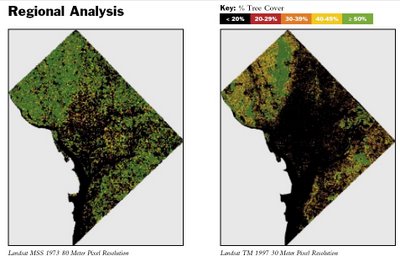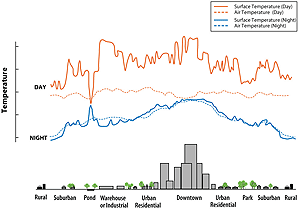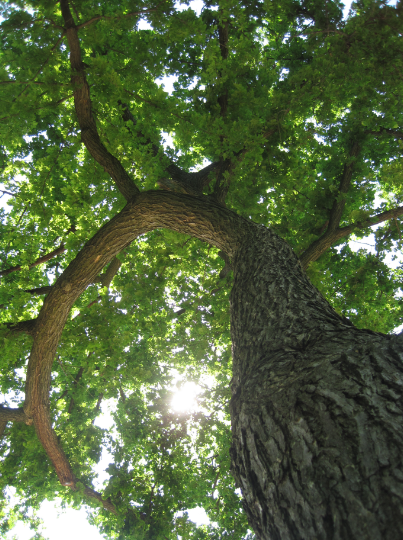Follow Horacio Terraza on twitter Español | English
As the northern hemisphere’s spring had brought verdant and vivid colors to fill the urban landscape, I couldn’t help but feel the absence of the tree that I shared with my neighbors that was uprooted during the last hurricane that hit the city. I think that the neighborhood will miss the shade it provided from the spring to the autumn. In my search to have another tree replanted, I began to ask myself about the role of trees in cities beyond the aesthetics they provide. For example, what is the objective of urban tree canopies? I came across many interesting facts about trees and tree canopies, which is defined as the layer of leaves and branches that cover the ground when viewed from above. At first I was interested in researching how the tree canopy has changed by looking at my city, Washington, D.C., as an example. For example, in figure 1 you can see the decrease in tree canopy from 1973 to 1997 (from left to right), with a notable tree canopy declined from 37% to 21%. One obvious reason for the decline could be attributed to an increase in urbanization; however, D.C. suffered a population decrease of 154,787 habitants from 1970 to 2000. Clearly, it was a phenomenon of policy.

Urban tree canopies are increasingly important in the context of climate change in various aspects. First, higher levels of precipitation are concentrated in fewer events climatic events and an increase of impervious urban areas are putting pressure on old urban drainage systems that were designed for a lower volumes or simply insufficient. All of these factors result in flash or slow-onset flooding, soil erosion, river flooding, etc. These effects can be lessened, in part, by increasing urban trees plantings.
For example, in one day, one large tree can lift up to 100 gallons (380 liters) of water out of the ground and discharge it into the air.[1] In fact, it is estimated that 33% of the total precipitation generally either returns by evaporation or evapotranspiration back into the atmosphere, 33% becomes surface water through runoff, and 33% recharges groundwater.[2]
Secondly, during the summer months, buildings, roads, and other hard surfaces retain the sun’s heat creating warmer surface and air temperatures in cities than suburban or rural areas. This occurrence, termed “heat island effect” (see the temperature variations in figure 2), can be partially mitigated through tree planting.

Evapotranspiration, alone or in combination with shading, can help reduce peak summer temperatures by 2–9°F (1–5°C).[3] [4] According to a study by National Aeronautics and Space Administration (NASA) demonstrated through satellite imagery that the summer land surface temperature of cities in the Northeast U.S. were an average of 13-16°F (7-9°C) warmer than surrounding rural areas over a three-year period.[5]
Lastly, and most obviously, is the importance of urban greenery as a way to mitigate the effects of climate change through carbon sequestration—or the process of capture and long-term storage of atmospheric carbon dioxide (CO2). For example, a thirty year-old laurel oak can absorb up to 69.5 pounds of carbon dioxide per year. [6] Maybe a lesser known effect is that trees are effective at removing both solid and gaseous particulates from the air. Also, in one study of the USDA Forrest Service that trees reduce particulates by 9 to 13 percent, and the amount of dust reaching the ground was 27 to 42 percent less under a stand of trees than in an open area.
Coming back to the original question: How can cities measure if they have a large enough tree canopy? It is difficult to find a rule regarding this measurement, but American Forests (an NGO involved in this topic) recommends at least a 40% tree canopy for cities. Many cities are establishing goals for themselves to reach higher levels of coverage. For Washington, D.C., which currently has a tree canopy of 35%, has a goal to obtain 40% coverage by 2035. In order to reach this goal, a total of 216,300 trees must be planted or 8,600 trees a year for the next two decades to reach its goal.(The calculation was completed by Casey Trees and assumes a 6 percent tree mortality rate per year and assumes that 100 trees equals 1 acre). This calculation can be done by aerial photos or ArcGIS software to map, measure, and quantify the benefits of urban tree canopy.
Urban landscapes and trees in particular must be seen as a common good and as an important element in planning for urban sustainability. How are evolving cities in LAC, incrementing or diminishing their tree canopy? Are their cities with established goals in this topic? We are going to continue writing this month about this topic, but in the meantime, we’d like to know: What is the percentage tree canopy in your city?
[1] Kramer, P.J., Kozlowski, T., 1960. Physiology of Trees. McGraw Hill, New York.
[2] UNESCO, Water e-Newsletter No. 172: The Hydrological Cycle, 19 January 2007 http://www.unesco.org/water/news/newsletter/172.shtml.
[3] Huang, J., H. Akbari, and H. Taha. 1990. The Wind-Shielding and Shading Effects of Trees on Residential Heating and Cooling Requirements. ASHRAE Winter Meeting, American Society of Heating, Refrigerating and Air-Conditioning Engineers. Atlanta, Georgia.
[4] Kurn, D., S. Bretz, B. Huang, and H. Akbari. 1994. The Potential for Reducing Urban Air Temperatures and Energy Consumption through Vegetative Cooling (PDF) (31 pp, 1.76MB). ACEEE Summer Study on Energy Efficiency in Buildings, American Council for an Energy Efficient Economy. Pacific Grove, California.
[5] Killingsworth, B. et al., Nov/Dec 2011. The Urban Heat Island Effect and Concrete’s Role in Mitigation Part I http://www.nrmca.org/members/ConcreteInFocus/Enviro%20Library/NRC-S0511_urban.pdf.
[6] U.S. Department of Energy, April 1998, ftp://ftp.eia.doe.gov/pub/oiaf/1605/cdrom/pdf/sequester.pdf.


Dear Horacio,
If you search IDB`s site with the words “areas verdes” you will find that IDB has made important contributions to the financing and study of the role of urban green areas for the welfare in cities and globally.
In special, you will find a landmark book published in 1998 ( http://bit.ly/iqYf23 ) which has been an important reference for LAC in these matters. In addition, IDB has financed a USD 200 million for the greening of Mexico City (http://bit.ly/10eEC84 ) in the 1990s, which is still one of the largest operations of its kind in the region.
Your interest in the matter could indicate that IDB is ready to restart its aactive role in these activities. Good luck.